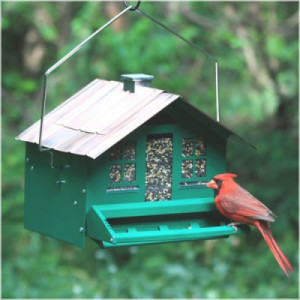The best place to start your birdwatching hobby is in your own backyard. Whether you design perennial beds in suburbia or turn over the back forty with country pleasure – there are birds in them there hills! Birds really are everywhere and they are just waiting to be found. All you have to do is look and listen.
Attracting species to your viewing area is easy. Just set out some “habitat” and “necessities” and the birds will be flying in.
Backyard Birding Ideas
Bird feeders and accessories are readily available. You can visit your local hardware store, grain supply store, garden center or visit a specialty bird supply store. Choose from the wide variety of bird feeders and which material suits your weather or feeding needs.
Materials: Feeders come in glass, recycled plastics, metal, traditional wood and combinations of these. Weight will be an issue. A heavy feeder with a volume allowance for 5 pounds of seed will require a sturdy mounting pole or branch (weather and wind will increase the effects). Remember that inexpensive plastic versions will fade, crack and discolor. Squirrels will chew wood and thin plastics.
Note: Quality plastic feeders are crafted to resemble faux-wood – they are fade resistant and ready to stand up to gnawing squirrels.
You may also want to consider suet combo feeders, nut feeders, sunflower trays and mixed seed tubes. Select a feeder that will last many seasons, as the cheapest isn’t always the best type to buy. Combination, or all-in-one stations, tend to be much more expensive. Plus, if suet cages are fixed to the feeder, this will make cleaning the station a chore. Cheaper really is better! Buy two separate feeders – the suet cage and the seed feeder – for a frugal purchase that requires less maintenance.
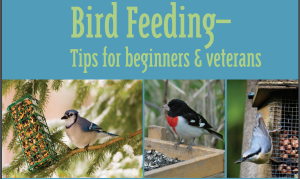 The first consideration will be to determine what bird species visit your area. Consult your bird guides or check out websites like the National Audubon Society’s (don’t forget to search through your local Audubon chapter’s website) or the University of Wisconsin: http://learningstore.uwex.edu/assets/pdfs/G3176.PDF.
The first consideration will be to determine what bird species visit your area. Consult your bird guides or check out websites like the National Audubon Society’s (don’t forget to search through your local Audubon chapter’s website) or the University of Wisconsin: http://learningstore.uwex.edu/assets/pdfs/G3176.PDF.
Cornell’s Ornithology Lab has a fun and interactive bird identification guide (with songs included) – http://www.allaboutbirds.org/guide/search.aspx.
Spend time sitting in your yard, or watching out the window, to note which birds are hanging around. Observation is a key element for bird watching and it is your best tool. Stroll nature preserves and research sightings in local parks and nature ways. Bring a birding guide, or birding app, to identify what birds you spot.
What Feeder to Buy
Bird feeders are made in a variety of models in order to provide the best feeding delivery of the seed provided. Feeders come in tube, hopper, barn or ranch hopper, lantern-shaped hopper and many other fancifully shaped forms (including, cats, fish, birds and outhouses). Feeders hang from a crook or limb, or mount to a pole or post. Other designs are engineered to attach to windows (great for apartment birders).
Knowing how and where you will be posting your stations narrows down the BEST ones suited for your bird species and needs. If you are planning to fill and check your feeder on a daily basis, buying a smaller model will be cheaper and it will give you the opportunity to monitor feeding selections and amounts. If you expect a high population of bird visiting the feeder, particularly in harsh winter areas, a larger hopper will be your better choice.
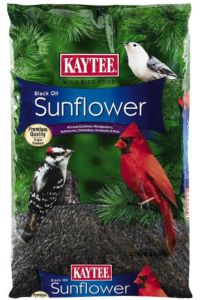 Always pick a feeder that will offer the seed that birds in your area will want. Supplying black oil sunflower is a sure bet in every region. Thistle, safflower, corn and red millet tend to attract the fewest birds.
Always pick a feeder that will offer the seed that birds in your area will want. Supplying black oil sunflower is a sure bet in every region. Thistle, safflower, corn and red millet tend to attract the fewest birds.
Feeding style by species:
- Cardinals, blue jays and grosbeaks are perching feeders; they will want a station that has a lip, large perch loops or bars, or a tray/shelf feeder.
- Birds like juncos, titmice, doves and game birds enjoy dining from under the feeder. The smaller songbirds (plus cardinals, jays and redwing blackbirds) will also use a tray feeder. If you live in a dry climate, like the Southwest, roofs and drainage will not be an issue, but for most other areas roofs and drains keep wet off the tray and prevent stagnant clumps of moldy seed. Squirrels also love tray feeders – so keep this in mind!
- Consider purchasing two stations and at least two different styled feeders. This prevents squabbling and ensures a variety of seed choices are offered. The classic tube hopper style is great for most feeding areas – it will attract finches, chickadees, warblers, sparrows and nuthatches. These feeders are filled with seed mixes and the preferred sunflower seeds.
Always buy quality seed. Clean, mold and insect–free seed holds the nutrition and maintains the health of your birds. Never purchase dusty, debris-filled, “buggy,” moldy or “cheap” mixes (red millet, corn). Birds will waste undesired seeds leaving you with a mess and an unhealthy scattering of molding seed under the feeders.
- Combination feeders blend several food holders into one attractive station, but as mentioned… they are expensive. They usually come with one or two suet cages that are affixed to the ranch-styled feeder. Some are hopper filled and others have the covered trough or shelf. These designs serve the needs of many species. One drawback of the suet cage combination is that…well, the cleaning gets complicated as the suet grease saturates the feeder and cleaning becomes a real chore whether you choose plastic or wood. The larger the model – the more awkward it is to fully clean.
Do your pre-purchase research before investing in your feeder. Like the squirrels at your feeding station you will certainly find yourself spoiled for choice!
Note: Never feed suspect, moldy or rodent infested feeds. Always clean and completely dismantle and scrub your feeder on a regular basis. The health of the birds depends on great quality feed and clean feeders.
Thistle and Suet Feeders
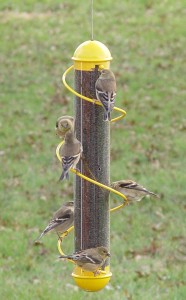 Thistle feeders are designed to hold only one type of food. Thistle, or nyjer, feeders come in a mesh feeding sock to allow the finches and nuthatches to nibble upside down — their preferred feeding position. Some tube thistle feeders are constructed without perches to frustrate sparrows. The ports on thistle feeders are extremely small, so only the tiny nyjer seeds will work with any of these feeders.
Thistle feeders are designed to hold only one type of food. Thistle, or nyjer, feeders come in a mesh feeding sock to allow the finches and nuthatches to nibble upside down — their preferred feeding position. Some tube thistle feeders are constructed without perches to frustrate sparrows. The ports on thistle feeders are extremely small, so only the tiny nyjer seeds will work with any of these feeders.
- Suet cages or log holders provide the suet enjoyed by woodpeckers, finches, bluebirds and nuthatches. Choose special trays to set out bluebird nuggets, peanuts and mealworms (bowls are sold that will hold live waxworms and mealworms).
- Fruit and nectar species have their own cafes! Buy bolt-type feeders that hold oranges and apples for orioles. Nectar feeders are built to hold the liquid mixes that attract hummingbirds. Some of these also support orioles. There are a wide variety of functional and decorative “liquid” bird feeders with reservoirs composed of either plastic or glass. Choose those with ant moats or bee deflectors.
Nectar feeders require frequent and thorough cleaning – a chore that will be made easier with a properly designed feeder.
Nuisance Species Solutions and Squirrel Feeders
If squirrels, blue jays and starlings become an issue at your main feeding station there are solutions. You can buy seed coated with hot pepper, squirrel domes and deflectors … or unique feeders. Brome’s “Squirrel Buster,” foils large birds and squirrels (http://bromebirdcare.com/about/) by deploying a weight tripped mechanism to keep squirrels and larger birds out.
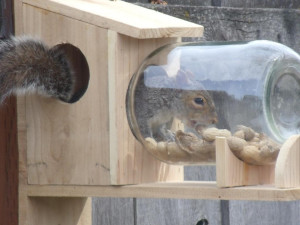 Often the easiest way to deal with squirrels is to give-in and buy these wily guys their own diner. There are clever and delightful squirrel table feeders (shaped like benches or picnic tables) that use a bolt screw to hold ears of corn — these will also attract blue jays.
Often the easiest way to deal with squirrels is to give-in and buy these wily guys their own diner. There are clever and delightful squirrel table feeders (shaped like benches or picnic tables) that use a bolt screw to hold ears of corn — these will also attract blue jays.
The style of bird feeder you choose is only limited by your personal taste! Whether you bird from a city balcony or hang feeders from the oak trees in the field, there will be hundreds of designs to choose from. In that case, we need to get shopping…those feeders aren’t going to choose themselves!
What feeder do you use? Did you find a unique station, a decorative one or a whimsical feeder that truly delights? Leave your tips, thoughts and words of advice in the comment section!

